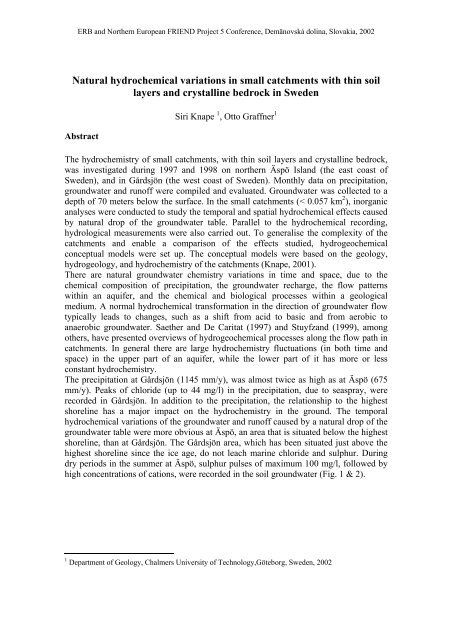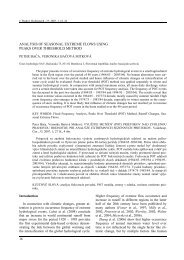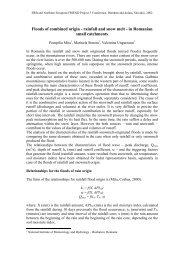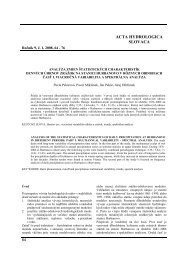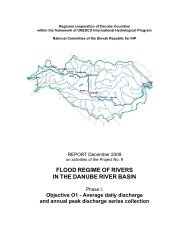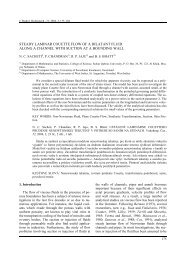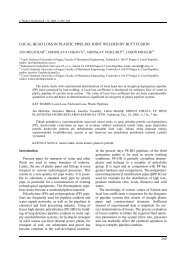Natural hydrochemical variations in small catchments with thin soil ...
Natural hydrochemical variations in small catchments with thin soil ...
Natural hydrochemical variations in small catchments with thin soil ...
Create successful ePaper yourself
Turn your PDF publications into a flip-book with our unique Google optimized e-Paper software.
ERB and Northern European FRIEND Project 5 Conference, Demänovská dol<strong>in</strong>a, Slovakia, 2002<strong>Natural</strong> <strong>hydrochemical</strong> <strong>variations</strong> <strong>in</strong> <strong>small</strong> <strong>catchments</strong> <strong>with</strong> th<strong>in</strong> <strong>soil</strong>layers and crystall<strong>in</strong>e bedrock <strong>in</strong> SwedenAbstractSiri Knape 1 , Otto Graffner 1The hydrochemistry of <strong>small</strong> <strong>catchments</strong>, <strong>with</strong> th<strong>in</strong> <strong>soil</strong> layers and crystall<strong>in</strong>e bedrock,was <strong>in</strong>vestigated dur<strong>in</strong>g 1997 and 1998 on northern Äspö Island (the east coast ofSweden), and <strong>in</strong> Gårdsjön (the west coast of Sweden). Monthly data on precipitation,groundwater and runoff were compiled and evaluated. Groundwater was collected to adepth of 70 meters below the surface. In the <strong>small</strong> <strong>catchments</strong> (< 0.057 km 2 ), <strong>in</strong>organicanalyses were conducted to study the temporal and spatial <strong>hydrochemical</strong> effects causedby natural drop of the groundwater table. Parallel to the <strong>hydrochemical</strong> record<strong>in</strong>g,hydrological measurements were also carried out. To generalise the complexity of the<strong>catchments</strong> and enable a comparison of the effects studied, hydrogeochemicalconceptual models were set up. The conceptual models were based on the geology,hydrogeology, and hydrochemistry of the <strong>catchments</strong> (Knape, 2001).There are natural groundwater chemistry <strong>variations</strong> <strong>in</strong> time and space, due to thechemical composition of precipitation, the groundwater recharge, the flow patterns<strong>with</strong><strong>in</strong> an aquifer, and the chemical and biological processes <strong>with</strong><strong>in</strong> a geologicalmedium. A normal <strong>hydrochemical</strong> transformation <strong>in</strong> the direction of groundwater flowtypically leads to changes, such as a shift from acid to basic and from aerobic toanaerobic groundwater. Saether and De Caritat (1997) and Stuyfzand (1999), amongothers, have presented overviews of hydrogeochemical processes along the flow path <strong>in</strong><strong>catchments</strong>. In general there are large hydrochemistry fluctuations (<strong>in</strong> both time andspace) <strong>in</strong> the upper part of an aquifer, while the lower part of it has more or lessconstant hydrochemistry.The precipitation at Gårdsjön (1145 mm/y), was almost twice as high as at Äspö (675mm/y). Peaks of chloride (up to 44 mg/l) <strong>in</strong> the precipitation, due to seaspray, wererecorded <strong>in</strong> Gårdsjön. In addition to the precipitation, the relationship to the highestshorel<strong>in</strong>e has a major impact on the hydrochemistry <strong>in</strong> the ground. The temporal<strong>hydrochemical</strong> <strong>variations</strong> of the groundwater and runoff caused by a natural drop of thegroundwater table were more obvious at Äspö, an area that is situated below the highestshorel<strong>in</strong>e, than at Gårdsjön. The Gårdsjön area, which has been situated just above thehighest shorel<strong>in</strong>e s<strong>in</strong>ce the ice age, do not leach mar<strong>in</strong>e chloride and sulphur. Dur<strong>in</strong>gdry periods <strong>in</strong> the summer at Äspö, sulphur pulses of maximum 100 mg/l, followed byhigh concentrations of cations, were recorded <strong>in</strong> the <strong>soil</strong> groundwater (Fig. 1 & 2).1 Department of Geology, Chalmers University of Technology,Göteborg, Sweden, 2002
Belowthe highestshorel<strong>in</strong>eAbovethe highestshorel<strong>in</strong>eUnsaturated zone8Mostly retardation8Dissolution of O 2 (g) and CO 2 (g):(CH 2 O) + O 2 (g) = CO 2 (g) + H 2 O =H 2 CO 3 = HCO 3-+ H +CO 2 (g) + H 2 O = H 2 CO 3 = HCO 3-+ H +8Carbonate and silicate dissolution, for example,CaCO 3 (s) + H + = Ca 2+ + HCO 3-8Cation exchange, for example,Ca 2+ + 2Na-X(s) = 2Na + + Ca-X(s)8Oxidation of the sulphur pool = SO 42-+ 2H +OrganicClay<strong>soil</strong>Runoff8Mostly advection and hydrodynamic dispersion8Cation exchange8CO 2 degassed8Fe 2 O 3 (s) precipitateTillBedrockSaturated zone8Mostly advection and hydrodynamic dispersion8Carbonate and silicate dissolution8Dissolution of soluble salts, for example,NaCl(s) = Na + + Cl -8Redox reactions, for example,½ Fe 2 O 3 (s) + 3H + + e - => Fe 2+ + 3/2 H 2 O1/8 SO 42-+ 9/8 H + + e - => 1/8 HS - + ½ H 2 O8Cation exchangeFig. 1. Qualitative conceptual model of the <strong>hydrochemical</strong> processes tak<strong>in</strong>g placedur<strong>in</strong>g low recharge <strong>in</strong> the <strong>catchments</strong> studied. Obvious effects are the appearanceof pulses of sulphate, cation and chloride, as well as the low redox potential <strong>in</strong> thegroundwater.Belowthe highestshorel<strong>in</strong>eAbovethe highestshorel<strong>in</strong>eUnsaturated zoneSaturated zone8Mostly retardation8Dissolution of O 2 (g) and CO 2 (g):(CH 2 O) + O 2 (g) = CO 2 (g) + H 2 O =H 2 CO 3 = HCO 3-+ H +CO 2 (g) + H 2 O = H 2 CO 3 = HCO 3-+ H +8Carbonate and silicate dissolution, for example,CaCO 3 (s) + H + = Ca 2+ + HCO 3-8Cation exchange, for example,Ca 2+ + 2Na-X(s) = 2Na + + Ca-X(s)Organic <strong>soil</strong>ClayRunoff8Mostly advection and hydrodynamic dispersion8Cation exchange8CO 2 degassed8Fe 2 O 3 (s) precipitateTillBedrockSaturated zone8Mostly advection and hydrodynamic dispersion8Carbonate and silicate dissolution8Dissolution of soluble salts, for example,NaCl(s) = Na + + Cl -8Redox reactions, for example,½ Fe 2 O 3 (s) + 3H + + e -
The deeper groundwater <strong>in</strong> the bedrock, at both Äspö and Gårdsjön, did not showseasonal <strong>variations</strong>, s<strong>in</strong>ce the groundwater table fluctuated approximately one meterover the year. Hydrogeological and <strong>hydrochemical</strong> studies <strong>in</strong>dicated that there is lowhydraulic connectivity between fractures <strong>in</strong> the bedrock aquifer at Äspö (Knape, 1999);the aquifer <strong>in</strong> Gårdsjön was the opposite. The concentration of dissolved organic carbonand iron <strong>in</strong>creased <strong>in</strong> correlation <strong>with</strong> drought periods (i.e. low groundwater rechargeperiods), <strong>in</strong> both groundwater and runoff. At Äspö the concentration rose to 190 mgDOC/l <strong>in</strong> the runoff.The study and the result<strong>in</strong>g hydrogeochemical conceptual models can also be applied asa support to predict<strong>in</strong>g a groundwater abstraction scenario <strong>in</strong> the <strong>catchments</strong> studied.ReferencesCaritat de, P. and Saether, O. M., 1997. Chemical changes attend<strong>in</strong>g water cycl<strong>in</strong>gthrough a catchment – An overview. In: Saether, O. M. and de Caritat, P. (eds.),Geochemical Processes, Weather<strong>in</strong>g and Groundwater Recharge <strong>in</strong> Catchments. A.A. Balkema, Rotterdam, Netherlands, pp. 305 – 328.Knape, S., 1999. Shallow groundwater quality <strong>variations</strong> <strong>with</strong><strong>in</strong> a hardrock aquifer. InKnutsson, G. (ed.); Proceed<strong>in</strong>gs of the Workshop on Hardrock Hydrogeology,Äspö, Sweden. NHP Report, No. 45.Knape, S., 2001. <strong>Natural</strong> Hydrochemical Variations <strong>in</strong> Small Catchments <strong>with</strong> Th<strong>in</strong> SoilLayers and Crystall<strong>in</strong>e Bedrock. A Two-year Study of Catchments on the East andWest Coasts of Sweden. Chalmers University of Technology, Department ofGeology, Licentiate thesis, Göteborg, Sweden.Stuyfzand, P. J., 1999. Patterns <strong>in</strong> groundwater chemistry result<strong>in</strong>g from groundwaterflow. Hydrogeology Journal, Vol. 7, pp. 15 – 27.


